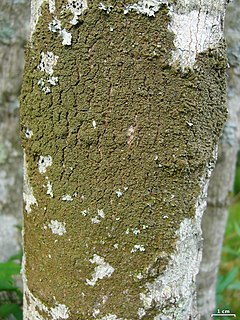
Parmelia is a genus of medium to large foliose lichens. It has a global distribution, extending from the Arctic to the Antarctic continent but concentrated in temperate regions. There are about 40 species in Parmelia. In recent decades, the once large genus Parmelia has been divided into a number of smaller genera according to thallus morphology and phylogenetic relatedness.

The Parmeliaceae is a large and diverse family of Lecanoromycetes. With over 2700 species in 71 genera, it is the largest family of lichen-forming fungi. The most speciose genera in the family are the well-known groups: Xanthoparmelia, Usnea, Parmotrema, and Hypotrachyna.

Melanohalea is a genus of foliose lichens in the family Parmeliaceae. It contains 30 mostly Northern Hemisphere species that grow on bark or on wood. The genus is characterized by the presence of pseudocyphellae, usually on warts or on the tips of isidia, a non-pored epicortex, and a medulla containing depsidones or lacking secondary compounds. Melanohalea was circumscribed in 2004 as a segregate of the morphologically similar genus Melanelia.

Melanelixia is a genus of foliose lichens in the family Parmeliaceae. It contains 15 Northern Hemisphere species that grow on bark or on wood. The genus is characterized by a pored or fenestrate epicortex, and the production of lecanoric acid as the primary chemical constituent of the medulla. Melanelixia was circumscribed in 2004 as a segregate of the related genus Melanelia.

Flavoparmelia is a genus of foliose lichens in the family Parmeliaceae. Because of their appearance, they are commonly known as greenshield lichens. The widely distributed genus contains 32 species. It was circumscribed by American lichenologist Mason Hale in 1986 to contain 17 former Pseudoparmelia species with broad lobes, usnic acid in the cortex, and isolichenan in the cell walls.

Punctelia is a genus of foliose lichens belonging to the large family Parmeliaceae. The genus, which contains about 50 species, was segregated from genus Parmelia in 1982. Characteristics that define Punctelia include the presence of hook-like to thread-like conidia, simple rhizines, and point-like pseudocyphellae. It is this last feature that is alluded to in the vernacular names speckled shield lichens or speckleback lichens.

Xanthoparmelia is a genus of foliose lichen in the family Parmeliaceae. Xanthoparmelia is synonymous with Almbornia, Neofuscelia, Chondropsis, Namakwa, Paraparmelia, and Xanthomaculina. This genus of lichen is commonly found in the United States, as well as Australia, New Zealand and Ecuador.

Xanthoparmelia loxodes is a species of foliose lichen in the family Parmeliaceae. It was first formally described by Finnish botanist William Nylander in 1872, as Parmelia loxodes. In 1978, Ted Esslinger created the genus Neofuscelia, which contained species previously classified in Parmelia subgenus Neofusca; Neofuscelia loxodes was one of many species transferred here. In a 2004 molecular phylogenetic study published by Oscar Blanco, Ana Crespo, John A. Elix, David L. Hawksworth and H. Thorsten Lumbsch, they showed that Neofuscelia did not form a clade distinct from Xanthoparmelia, and they reduced it to synonymy under Xanthoparmelia.
Xanthoparmelia salazinica is a species of lichen in the family Parmeliaceae. Found in South Africa, it was described as a new species in 1989 by American lichenologist Mason Hale. He classified it in Karoowia, a genus that has since been placed in synonymy with Xanthoparmelia following molecular phylogenetic analysis published in 2010.

Parmelina quercina is a species of foliose lichen in the large family Parmeliaceae. It is found in continental Europe.
Xanthoparmelia isidiovagans is a species of foliose lichen in the family Parmeliaceae
Xanthoparmelia bainskloofensis is a species of saxicolous (rock-dwelling), foliose lichen in the family Parmeliaceae. It was formally described as a new species in 2002 by lichenologists John Elix and Thomas Hawkes Nash III. The type specimen was collected by Nash from Bainskloof Pass at an altitude of 600 m (2,000 ft), where it was found growing on acidic rock. The species epithet refers to the type locality, the only place the lichen is known to occur. It contains usnic acid as a major lichen product, and minor amounts of echinocarpic acid, conechinocarpic acid, and hypothamnolic acid.
Xanthoparmelia boyeri is a species of foliose lichen in the family Parmeliaceae. Found in Kenya, it was formally described as a new species in 2002 by Australian lichenologist John Elix. The type specimen was collected from the Lewis Glacier on Mount Kenya, where it was found growing on volcanic rock. The species epithet refers to M. Boyer, one of the collectors of the type. The lichen contains salazinic acid as a major lichen product, minor amounts of usnic acid and norstictic acid, and trace amounts of consalazinic acid.
Xanthoparmelia kleinswartbergensis is a species of saxicolous (rock-dwelling), foliose lichen in the family Parmeliaceae. Found in South Africa, it was formally described as a new species in 2002 by Australian lichenologist John Elix. The type specimen was collected from Klein Swartberg, where it was found growing on large boulders in a gorge. It contains protocetraric acid as a major lichen product, minor amounts of usnic acid and anhydrofusarubin lactol, and trace amounts of anhydrofusarubin lactol methyl ketal. The species epithet refers to the type locality, the only place the lichen is known to occur.
Xanthoparmelia lobuliferella is a species of saxicolous (rock-dwelling), foliose lichen in the family Parmeliaceae. Found in South Africa, it was formally described as a new species in 2002 by Australian lichenologist John Elix. The type specimen was collected from the Jonaskop mountain at an altitude of 1,600 m (5,200 ft); there it was found growing on south-facing rocks. It contains several lichen products: major amounts of usnic acid and stictic acid, and minor amounts of constictic acid, norstictic acid, cryptostictic acid, lobaric acid, stenosporonic acid, lichesterinic acid, and protolichesterinic acid. The species epithet refers to its resemblance to Xanthoparmelia lobulifera.
Xanthoparmelia malawiensis is a species of saxicolous (rock-dwelling), foliose lichen in the family Parmeliaceae. Found in Malawi, it was formally described as a new species in 2002 by Australian lichenologist John Elix. The type specimen was collected in Nyika National Park at an altitude of 2,300 m (7,500 ft), where it was found growing on granite rocks. It is only known from the type locality. It contains usnic acid and stictic acid as major lichen products, and minor amounts of constictic acid, norstictic acid, cryptostictic acid, and lusitanic acid.
Xanthoparmelia micromaculata is a species of saxicolous (rock-dwelling), lichen in the family Parmeliaceae. Found in South Africa, it was formally described as a new species in 2002 by Australian lichenologist John Elix. The type specimen was collected from the summit of Waboomsberg mountain at an altitude of 1,220 m (4,000 ft). It is only known from the type locality. The lichen has a pale yellow-green, somewhat crustose thallus, reaching a diameter of up to 1 cm (0.4 in) wide. It contains several lichen products: stictic acid as a major metabolite, minor amounts of usnic acid, constictic acid, and hypostictic acid, and minor or trace amounts of norstictic acid, hyposalazinic acid, and cryptostictic acid. The species epithet refers to the prominent maculae on the thallus surface.
Xanthoparmelia waboomsbergensis is a species of foliose lichen in the family Parmeliaceae. It was formally described as a new species in 2002 by Australian lichenologist John Elix. The type specimen was collected from the summit of Waboomsberg mountain at an altitude of 1,220 m (4,000 ft). The species epithet refers to the type locality, the only place the lichen is known to occur.

Constictic acid is a chemical compound of the depsidone class. It was first isolated in 1968 from lichen of the genus Usnea. It has since been found in many other lichen genera including Menegazzia, Crespoa, and Xanthoparmelia.









